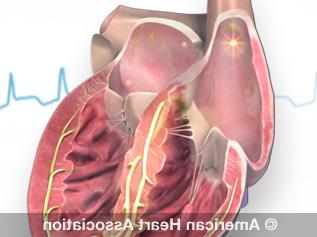非外科手术 for 心房纤颤
电复律,心律恢复
电复律法 is a procedure in which a patient receives an electrical shock on the outside of the chest (while under mild anesthesia) using either paddles or patches. The shock can be used to “reset” the heart to a normal rhythm. The procedure is similar to defibrillation but uses much lower levels of electricity.
The decision to use electrical cardioversion
Your health care professional may recommend a 经食管超声心动图 作为第一步. The TEE procedure involves swallowing a small ultrasound device that allows the health care team to view the inside your heart atria for blood clots.
If you already have clots in the atria, you will need protection from increasing your stroke risk. So your health care professional may recommend a *blood thinner before an electrical cardioversion procedure. 电复律法 often successfully restores a regular heart rhythm. 但 心房纤颤也称为房颤或房颤,可能会复发. In many instances, you may need anti-arrhythmia 药物 indefinitely to keep your heart’s rhythm and rate in the best range.
Radiofrequency ablation or catheter ablation
消融 is a procedure for cardiac arrhythmias if long-term 药物 or electrical cardioversion are not preferred or were not effective. 消融手术前, doctors perform electrical mapping of the heart using an electrically sensitive catheter to map the origins of “extra” electrical activity throughout the heart. The map tells the doctor which areas of the heart are creating problematic electric signals that interfere with the proper rhythm.
消融是如何进行的?
A catheter is inserted into a blood vessels and gently guided to the heart. The doctor carefully destroys malfunctioning tissue using the catheter to deliver energy (such as radiofrequency, laser or cryotherapy) to scar the problematic areas. The scarred areas will no longer send abnormal signals.
If successful, the heart will return to a normal rhythm. AFib may return, so multiple ablation procedures may be needed. This minimally invasive procedure usually has a short recovery period. Patients are generally placed on a short course of anti-arrhythmic drugs while the procedure takes full effect.
房颤常用的消融术包括:
- Pulmonary vein isolation ablation (PVI ablation or PVA). In some AFib patients, fibrillation is triggered by extra electrical currents in the pulmonary veins. 在这个过程中, doctors use the catheter tip to destroy the tissue that is sending the extra currents. 在大多数情况下,心脏节律恢复正常.
- 起搏器消融房室结. 在其他房颤患者中, the trigger for their AFib occurs in the atrioventricular node (where the electrical signals pass from the atria to the ventricles). Doctors place the catheter near the AV node and destroy a small area of tissue. They then implant a pacemaker to restore and maintain the heart’s normal rhythm.







